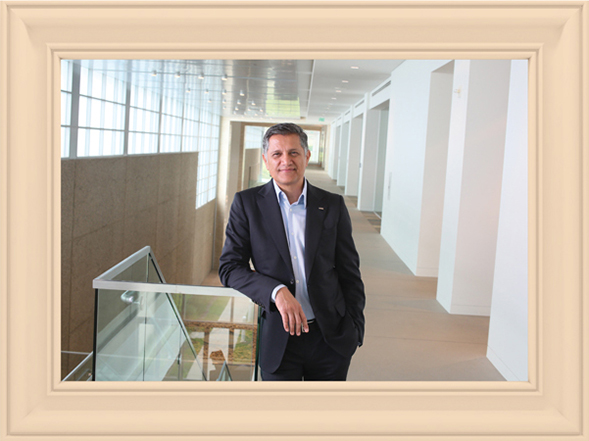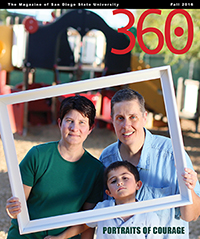Portraits of Courage: Joe Kiani
This Aztec is leading the fight to eliminate preventable hospital deaths.

This is the second of four "Portraits of Courage," a series featuring courageous Aztecs who fight to make the world a better place for themselves, their families and their communities. The stories also appear in the fall 2016 issue of 360: The Magazine of San Diego State University.
The stories keep Joe Kiani awake at night. Mishandled blood test results that led to a child’s death. Symptoms of deadly sepsis overlooked. They are stories of pain and second-guessing from the families of the more than 200,000 people who die each year due to preventable hospital error.

Kiani, (’85, ’87), has shared the stories with audiences around the world as he solicits support for the Patient Safety Movement he founded in 2012. Its ambitious goal is the elimination of preventable hospital deaths—and the more than $1 trillion spent annually treating medical errors—by the year 2020.
Signatories to the Patient Safety Movement include more than 1,600 healthcare organizations and 45 healthcare technology companies; legislators, university researchers, global partners from Spain, Germany, and the United Kingdom; and former U.S. President Bill Clinton.
These numbers and names are impressive, but Kiani won’t settle for endorsements alone. At each Patient Safety and Technology Summit—the fifth annual is scheduled for February 2017— he tells attendees to take documentable action within the next 12 months or stay at home the following year.
“To err is human,” Kiani said, “but to fail to establish processes to fix those errors; that’s inhumane.”
A higher standard
An engineer and entrepreneur, Kiani has walked a tortuous path to the world stage, one obstructed by protracted legal battles, threats from giant U.S. corporations and ethical conundrums.
“It’s difficult to make the right decisions in corporate America, always has been,” he said. “I decided early on that my business ethics had to reflect my personal ethics.”
Kiani is the youngest of three children born to an engineer and a nurse. He enrolled in San Diego State University at age 15, intending to become a doctor, but switched to electrical engineering. Working several jobs and a paid internship, Kiani completed both bachelor’s and master’s degrees by age 22. Two years later, he launched Masimo, now a publicly traded global medical technology company.
Revolutionary product
During his early years as an engineer, Kiani, became absorbed by an idea for refining medical monitoring devices to reduce false readings. In the 1980s, these monitoring devices used a rudimentary form of signal processing. Kiani likens it to a standard window screen.
Now imagine a screen whose meshwork could enlarge or contract depending on weather conditions or the presence of insects. That kind of filtering requires a more sophisticated technique known as adaptive signal processing.
Masimo served as Kiani’s platform to build better medical monitoring devices with adaptive signal processing. He succeeded, and in doing so, he and his team of researchers discovered the solution to a problem that had bedeviled the industry for decades.
Their work revolutionized pulse oximetry, a simple test used to measure the oxygen saturation of the blood. Previous pulse oximetry devices measured two parameters of blood saturation, but Masimo’s new device could measure 11 parameters. Its sensitivity enabled medical professionals to find previously undetectable heart problems in newborns and problems that could lead to blindness or death.
The main character
Despite the breakthrough, Masimo was unable to sell its product to major U.S. hospitals. Group purchasing organizations (GPOs) had a lock on that market, and they were paid by dominant medical technology companies to keep newcomers out.
“There we were, cleared by the Food and Drug Administration, with a product proven to cut down on false readings and proven to save the eyesight of vulnerable infants, but the hospitals couldn’t buy it because they had watertight contracts with the GPOs,” Kiani explained.
One day in 2000, Kiani received a call from Pulitzer Prize–winning journalist Walt Bogdanich. The reporter wanted to write for the New York Times about the monopoly of the GPOs and powerful medical companies—with Kiani as a main character. “I suspected I’d be blackballed if I did it, but I couldn’t just walk away,” Kiani recalled.
“Sometimes the unintended consequences of what you do are more profound than you expect. The story changed my life and opened my eyes to what’s possible if you get engaged. Afterwards, I received grateful phone calls from other companies that had been locked out of the market, too.”
No more errors
The day Bogdanich’s story ran in March 2002, Kiani was called to testify before the Senate Judiciary Committee. Sitting with him at the Senate hearing, were the CEOs of the two largest GPOs “and they were getting slammed,” he said. Congress has since curbed the purchasing monopoly that plagued the industry.
Today, Kiani is a hero of the medical technology field. He bested 64 other nominees to win the 2015 Person of the Year Award from SafeCare Magazine and became the first non-legislator to receive the Hubert H. Humphrey Dawn of Life Award, which recognizes his “visionary leadership increasing the role of technology and innovation in improving the health of newborns around the world.”
The awards are appreciated, but Kiani’s sleepless nights won’t end until his patient safety movement reaches its goal of zero preventable hospital deaths.



